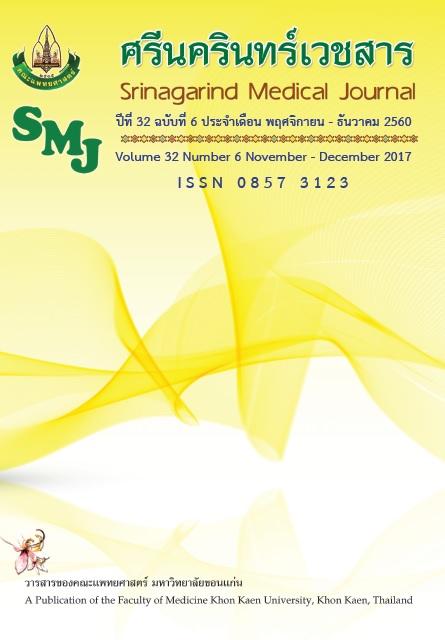Anaphylaxis in Emergency Room Srinagarind Hospital : A 5-Years Retrospective Study
Keywords:
AnaphylaxisAbstract
Background and objective: Anaphylaxis is a potentially life-threatening allergic reaction that involves multi-organ systems. It can develop in short time and cause fatal. The objective of this study was to determine incidence, cause, the way patients come to hospital, diagnosis, treatment, complication and revisited patient who known their allergen to be information for improves treatment and education people.
Methods: This was a retrospective descriptive study, data were collected from patients whom visit emergency department in 1 June 2008 - 31 May 2013 which had diagnosis of anaphylaxis and anaphylactic shock.
Results: There were 245 patients; 141 male (57.6%) and 104 female (42.4%). Mean age is 27.9 years. There are 149 patients (60.8%) with atopic underlying and 53 (21.6%) have other underlying. Most of patients come to hospital by themselves. Most common allergen was food (41.2%). Most patients (53.5%) contact allergen by eating. There were 17.1% of patients who had ever diagnosed anaphylaxis. There were 40% of patients known the allergen. Skin and mucocutaneous were the most common symptom (95.1%). 55 patients (22.4%) had anaphylactic shock. Contact to symptom time mean was 113.4 min. Symptom to arrive hospital time mean was 172 min. Symptom to adrenaline time mean was 118.9 min. Hospital arriving to get adrenaline mean was 17.1 min. Most patients received adrenaline at 5 min after hospital arrival. The patients were treated by Adrenaline 76.3%. Most patients were admitted (73.9%) and admission time was about 1 day (68.5%). There are 3 Biphasic patients.
Conclusion: Prevalence of anaphylaxis in this study was 76:100,000 patients. Most affect patients were teenage and young adult. Most patients were treated with intramuscular adrenaline injection followed standard guideline and were admitted in hospital to observation. We found some patients known their allergen but they also came to hospital with anaphylaxis again. Education to physician in order to get appropriate diagnosis and treatment and to educate patients for avoiding allergen are important.
References
2. Lertnawapan R, Maek-a-nantawat W. Anaphylaxis and Biphasic Phase in Thailand: 4-year Observation. Allergology International 2011; 60: 283–9.
3. Moneret-Vautrin DA, Morisset M, Flabbee J, Beaudouin E, Kanny G. Epidemiology of life-threatening and lethal anaphylaxis: a review. Allergy 2005; 60: 443–51.
4. Neugut AI, Ghatak AT, Miller RL. Anaphylaxis in the United States: an investigation into its epidemiology. Arch Intern Med 2001; 161: 15-21.
5. Koplin JJ, Martin PE, Allen KJ. An update on epidemiology of anaphylaxis in children and adults. CurrOpin Allergy ClinImmunol 2011; 11: 492–6.
6. Tanno LK, Ganem F, Demoly P, Toscano CM, Bierrenbach AL. Undernotification of anaphylaxis deaths in Brazil due to difficult coding under the ICD-10. Allergy 2012; 67: 783-9.
7. Sampson HA, Munoz-Furlong A, Campbell RL, Adkinson NF Jr, Bock SA, Branum A, et al. Second symposium on the definition and management of anaphylaxis: summary report: Second National Institute of Allergy and Infectious Disease/Food Allergy and Anaphylaxis Net- work Symposium. J Allergy ClinImmunol 2006; 117: 391–7.
8. Lauritano EC, Novi A, Santoro MC, Casagranda I.Incidence, clinical features and management of acute allergic reactions: the experience of a single, Italian Emergency Department.Eur Rev Med Pharmacol Sci 2013; 17: 39-44.
9. Poachanukoon O, Paopairochanakorn C. Incidence of anaphylaxis in the emergency department: a 1-year study in a university hospital. Asian Pac J Allergy Immunol 2006; 24: 111–6.
10. Panesar SS, Javad S, De Silva D, Nwaru BI, Hickstein L, Muraro A et al. The epi- demiology of anaphylaxis in Europe: a systematic review. Allergy 2013; 68: 1353–61.
11. Moro Moro M, Tejedor Alonso MA, Esteban Hernandez J, Mugica Garcia MVM, Rosado IngelmoA, Vila Albelda C. Incidence of anaphylaxis and subtypes of anaphylaxis in a general hospital emergency department. J InvestigAllergolClinImmu- nol 2011; 21: 142–9.
12. Wang J, Young MC, Anna Nowak-Węgrzyn. International survey of knowledge of food-induced anaphylaxis. Pediatric Allergy and Immunology 2014; 25: 644-50.
13. Techapornroong M, Akrawinthawong K, Cheungpasitporn W, Ruxrungtham K. Anaphylaxis: a ten years inpatient retrospective study. Asian Pac J Allergy Immunol 2010; 28: 262–9.
14. Lauritano EC, Novi A, Santoro MC, Casagranda I. Incidence, clinical features and management of acute allergic reactions: the experience of a single, Italian Emergency Department. Eur Rev Med Pharmacol Sci 2013; 17: 39–44.
15. Pluemchitmongkhon P. Clinical manifestations of Anaphylaxis at the Emergency Department. KKMJ 2011; 35: 36–43.
16. ปิยะภาณี นันทวัน. รายงานวิทยานิพนธ์เรื่องระบาดวิทยาของ Anaphylaxis ในโรงพยาบาลศิริราช. กรุงเทพ: ภาควิชากุมารเวชศาตร์ คณะแพทยศาสตร์ศิริราชพยาบาล, 2547.
17. Westfall TC. Adrenergic agonists and antagonists. In: Chabner BA, Brunton LL, Knollmann BC, editors. Goodman and Gilman’s the Pharmacological Basis of Therapeutics. New York: Mc Graw-Hill 2006; 215–68.
18. Lieberman P, Nicklas RA, Oppenheimer J, et al. The diagnosis and management of anaphylaxis practice parameter:2010 update. J Allergy Clin Immunol 2010; 126: 477–80.
19. Järvinen KM, Celestin J. Anaphylaxis avoidance and management: educating patients and their caregivers. J Asthma Allergy 2014; 7: 95–104.
20. Sánchez J. Anaphylaxis. How often patients carry epinephrine in real life? Rev Alerg Mex 2013; 60: 168–71.




